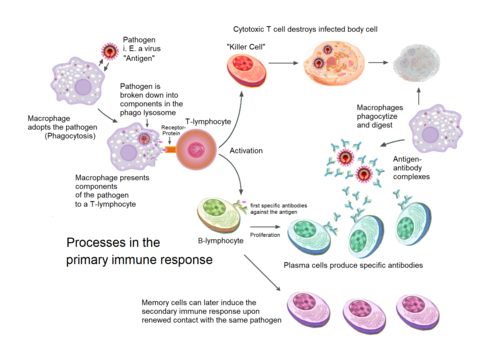
An introduction to the human immune system
The immune system is a host defense system and comprises many biological elements ranging from white blood cells to entire organs and many complex biological processes. The function of the immune system is to protect the host from pathogens and other causes of disease such as tumor cells. This introduction to the immune system will explore the cell types and other structures involved in human immune reactions important for defense and homeostasis maintenance (1).
Two lines of defense: innate and adaptive immunity
The immune system can be divided into two types: innate immunity and adaptive immunity. Innate immunity represents the first line of defense against a foreign pathogen. It relies on an antigen-dependent, non-specific defense mechanism that activates immediately or within hours upon encountering the thread.
Adaptive immunity, on the other hand, is antigen-dependent and antigen-specific and involves a delay between antigen exposure and maximal response. The hallmark of adaptive immunity is its ability of immunological memory which enables the host to mount a more rapid and efficient immune response upon subsequent exposure to the same antigen. Innate and adaptive immunity are not mutually exclusive mechanisms of host defense, but they are rather complementary (2,3).
Components of innate immunity
The innate immune system includes physical and anatomical barriers, effector cells, antimicrobial peptides, soluble mediators, and cell receptors. Skin and mucosal barriers act as physical barriers and prevent microbial entry. Effector cells like granulocytes, monocytes, dendritic cells, and natural killer cells play a role in phagocytosis and cytokines and enzyme production to kill pathogens and remove them from the body.
Antimicrobial peptides also help in the destruction of invading pathogens. Other components of innate immunity including cytokines, complement systems, collectins, and cellular receptors have a wide range of functions, all aiming at recognizing a variety of pathogens, opsonizing the pathogen, and regulating the inflammation process (2).
Components of adaptive immunity
The adaptive immune system takes over when the innate immune system is not enough to destroy the pathogens. The adaptive immune system includes:
● T lymphocytes and B lymphocytes circulate in the blood and enter the infected tissues
● Antibodies in the blood and other bodily fluids (4,5)
References
1. Rossi A. Understanding the immune system. Posit Aware. 1998 Nov-Dec;9(6):28. PMID: 11366476.
2. Janeway CA Jr, Medzhitov R. Innate immune recognition. Annu Rev Immunol. 2002;20:197-216. doi: 10.1146/annurev.immunol.20.083001.084359. Epub 2001 Oct 4. PMID: 11861602.
3. Chaplin DD. 1. Overview of the immune response. J Allergy Clin Immunol. 2003 Feb;111(2 Suppl):S442-59. doi: 10.1067/mai.2003.125. PMID: 12592292. 4. https://www.ncbi.nlm.nih.gov/books/NBK279396/
5. McDaniel MM, Meibers HE, Pasare C. Innate control of adaptive immunity and adaptive instruction of innate immunity: bi-directional flow of information. Curr Opin Immunol. 2021 Dec;73:25-33. doi: 10.1016/j.coi.2021.07.013. Epub 2021 Aug 20. PMID: 34425435; PMCID: PMC8648974.



